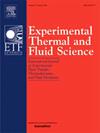Effect of stratification on thermoacoustic instability, emissions, and flame macrostructure in a swirl-stabilized dual annular burner: An experimental study
IF 3.3
2区 工程技术
Q2 ENGINEERING, MECHANICAL
Experimental Thermal and Fluid Science
Pub Date : 2025-09-16
DOI:10.1016/j.expthermflusci.2025.111620
引用次数: 0
Abstract
Stratified flames have attracted significant attention due to their superior resilience to turbulence and enhanced flame stability, enabling reduced NOx and CO emissions. In this study, an innovative dual annular stratified burner was designed and experimentally investigated to characterize thermoacoustic instability, emissions and flame macrostructure in swirling and non-swirling (jet) methane-air flames. Experiments were systematically conducted across stratification ratios (SR = 1–3) and global equivalence ratios (Φg) ranging from lean blowoff to rich conditions (Φg = 1.2). Swirling flames exhibited consistently acceptable emissions (NOx and CO < 20 ppm) under stable lean operating conditions (Φg = 0.55–0.8) for all SRs tested. Jet flames showed no thermoacoustic instabilities irrespective of SR or Φg variations. Similarly, swirling flames remained stable for Φg < 0.8; however, at Φg = 0.8, thermoacoustic instability initiated, characterized by coupled oscillations of acoustic pressure and heat release fluctuations. These oscillations were sustained until Φg = 1.1, beyond which decoupling occurred. Limit cycle oscillations with heightened sound pressure amplitudes were observed at lower stratification ratios (SR = 1–1.5), whereas no limit cycles were detected at higher SR values (>1.5). Increasing SR significantly suppressed instability amplitudes, notably resulting in a 70 % reduction of oscillation amplitudes at Φg = 0.9 when SR increased from 1 to 3. Flame macrostructure analysis confirmed improved anchoring and mixing characteristics of swirling flames compared to jet flames, particularly at higher SR conditions. This work highlights that controlled stratification effectively enhances operational stability and produces more compact flames in swirling combustors, offering valuable insights for developing low-emission and high-efficiency combustion systems.
涡流稳定双环形燃烧器中分层对热声不稳定性、发射和火焰宏观结构的影响:一项实验研究
分层火焰由于其对湍流的优越恢复能力和增强的火焰稳定性而引起了极大的关注,从而减少了氮氧化物和一氧化碳的排放。在这项研究中,设计了一种创新的双环形分层燃烧器,并对其进行了实验研究,以表征旋转和非旋转(射流)甲烷-空气火焰的热声不稳定性、发射和火焰宏观结构。实验系统地进行了分层比(SR = 1-3)和整体等效比(Φg),范围从贫吹到富条件(Φg = 1.2)。在稳定的精益操作条件下(Φg = 0.55-0.8),所有测试的旋转火焰都显示出可接受的排放(NOx和CO <; 20ppm)。射流火焰没有表现出热声不稳定性,与SR或Φg的变化无关。同样,旋转火焰在Φg <; 0.8;然而,当Φg = 0.8时,热声不稳定开始,其特征是声压和热释放波动的耦合振荡。这些振荡一直持续到Φg = 1.1,超过这个时间就发生了解耦。在较低的分层比(SR = 1-1.5)下观察到声压振幅增大的极限环振荡,而在较高的SR值(>1.5)下没有检测到极限环。增加SR可显著抑制不稳定振幅,尤其当SR从1增加到3时,在Φg = 0.9处振荡振幅降低70%。火焰宏观结构分析证实,与喷射火焰相比,旋流火焰的锚定和混合特性有所改善,特别是在高SR条件下。这项工作强调了控制分层有效地提高了旋转燃烧器的运行稳定性,并产生了更紧凑的火焰,为开发低排放和高效的燃烧系统提供了有价值的见解。
本文章由计算机程序翻译,如有差异,请以英文原文为准。
求助全文
约1分钟内获得全文
求助全文
来源期刊

Experimental Thermal and Fluid Science
工程技术-工程:机械
CiteScore
6.70
自引率
3.10%
发文量
159
审稿时长
34 days
期刊介绍:
Experimental Thermal and Fluid Science provides a forum for research emphasizing experimental work that enhances fundamental understanding of heat transfer, thermodynamics, and fluid mechanics. In addition to the principal areas of research, the journal covers research results in related fields, including combined heat and mass transfer, flows with phase transition, micro- and nano-scale systems, multiphase flow, combustion, radiative transfer, porous media, cryogenics, turbulence, and novel experimental techniques.
 求助内容:
求助内容: 应助结果提醒方式:
应助结果提醒方式:


